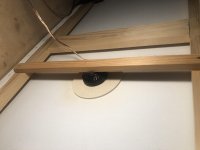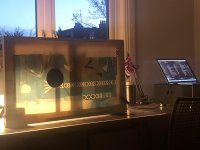Having stretched a LOT of canvas, I know that tension is variable. One would hope that the manufactured canvases would at least be consistent between brands. Hint: To tighten the canvas on the frame, use a spray bottle to spritz a little water on the back. This will make the fibers shrink and pull tighter. The change will last a long time.
Very cool idea, have fun!
Very cool idea, have fun!
There will be canvases on sale next Thursday here. I buy two sets and after I mount the exciters, I will do some FR measurements for sure. If that will work well hanged on a wall, then I have solved the problem of living room speakers
Through my experiences so far, putting them tight against a wall does constrict the bass response. 4-6" away is ideal with some sound absorbing material mounted to the wall to attenuate the higher frequencies. They are actually "Brighter" on the rear, meaning the treble response is more pronounced..
Would a long, and relatively thin surface work for DML speakers? With weights at the bottom these could be kept permanently under tension.
Yes.
Would something similar to a triangular hammock work as a surface? They use a very thin nylon/polyester composite reinforced with seatbelt material, which can take tons of stretching force. Would this allow for a larger surface and lower bass cutoff?
Has anybody tried applying constrained layer damping to DML panels?
In the giant Audio Circle DML thread I came across this paper:
https://eprints.soton.ac.uk/369232/1/Eprints.pdf
It seems counter intuitive, but the article shows that a panel with a sufficient loss factor will have greater radiation efficiency than a panel with a very low loss factor. This boost in efficiency occurs in the region between the fundamental frequency of the panel and the coincidence frequency. In addition, increasing the loss factor smooths out the bumps in the radiation efficiency in this same frequency region.
If correct, this would suggest that adding a damping layer to the panel could improve a DML.
I'm thinking of trying something like one of these products on the back side of my test panels:
Sonic Barrier UT-4 Ultra Sound Vibration Damping Sheets with Foil 15.5 sq. ft. 31.5" x 18.1" 4 pcs.
Boom Mat Tape Sound-damping tape — 2-inch wide, 20-foot roll at Crutchfield
Have any of you tried something like this, or know anyone that has?
Thanks
Eric
In the giant Audio Circle DML thread I came across this paper:
https://eprints.soton.ac.uk/369232/1/Eprints.pdf
It seems counter intuitive, but the article shows that a panel with a sufficient loss factor will have greater radiation efficiency than a panel with a very low loss factor. This boost in efficiency occurs in the region between the fundamental frequency of the panel and the coincidence frequency. In addition, increasing the loss factor smooths out the bumps in the radiation efficiency in this same frequency region.
If correct, this would suggest that adding a damping layer to the panel could improve a DML.
I'm thinking of trying something like one of these products on the back side of my test panels:
Sonic Barrier UT-4 Ultra Sound Vibration Damping Sheets with Foil 15.5 sq. ft. 31.5" x 18.1" 4 pcs.
Boom Mat Tape Sound-damping tape — 2-inch wide, 20-foot roll at Crutchfield
Have any of you tried something like this, or know anyone that has?
Thanks
Eric
I believe in the second Tech Ingredients video the guy tried covering the back of a free panel completely with some kind of elastic damping material (don't remember what they called it). They even tested it with a freq sweep and showed the results so you could see and hear the difference between a panel without the damping material and a panel with. They must not have considered it an improvement because they did not choose it in their final build.
OK its in the second TI video at the 20 min mark. They used a "Silastic/Silicone" damping material...
geo
OK its in the second TI video at the 20 min mark. They used a "Silastic/Silicone" damping material...
geo
Last edited:
Sounds great. What size is the panel?Here's another DIY "wood" DML Panel...Sounds pretty good...
This is Home Depot 1/8th Birch cabinet plywood with water based poly urethane lacquer powered by a Dayton audio exciter. DAEX30HESF-4
YouTube
geo
Sounds great. What size is the panel?
Unfortunately, the guy didn't say, unless its buried in the comments.
Canvas experiments.
So as the sun was going down on Great Britain
... for what feels like the last time, I thought I would try the canvas frame technique and share thoughts. I had a print I was given by an artist that I was not to keen on, his other work is great and I have bought a lot from him, but this one is not his best. I had to hand an exciter and about an hour so gave it a try. I fixed the exciter to a brace and used a 120mm ply disc as per the recipe.
First thoughts are:-
All the DML benefits are there, lots of clarity and attack, pretty smooth response similar to my ply panels, very engaging sound.
You get bass! I measured it down to 40hz. This is recessed compared to the midrange but this was just a first try so any deficiencies are down to me.
Your frame and brace needs to be well built and attachment to the exciter need to be solid. A lot of energy gets passed to the frame and I had some buzzing and rattles when I turned up the power. How much energy? Well the frame started ‘walking’ across the table on really bass heavy tracks e.g. Basshead from Far East Movement.
The canvas needs a good tension to perform well, I used inserts between the frame and the canvas to increase the tension and I got best results with a taught canvas which sounded 'drum-like' when tapped with a finger.
So its a very promising method and I look forward to exploring it further
So as the sun was going down on Great Britain
... for what feels like the last time, I thought I would try the canvas frame technique and share thoughts. I had a print I was given by an artist that I was not to keen on, his other work is great and I have bought a lot from him, but this one is not his best. I had to hand an exciter and about an hour so gave it a try. I fixed the exciter to a brace and used a 120mm ply disc as per the recipe.
First thoughts are:-
All the DML benefits are there, lots of clarity and attack, pretty smooth response similar to my ply panels, very engaging sound.
You get bass! I measured it down to 40hz. This is recessed compared to the midrange but this was just a first try so any deficiencies are down to me.
Your frame and brace needs to be well built and attachment to the exciter need to be solid. A lot of energy gets passed to the frame and I had some buzzing and rattles when I turned up the power. How much energy? Well the frame started ‘walking’ across the table on really bass heavy tracks e.g. Basshead from Far East Movement.
The canvas needs a good tension to perform well, I used inserts between the frame and the canvas to increase the tension and I got best results with a taught canvas which sounded 'drum-like' when tapped with a finger.
So its a very promising method and I look forward to exploring it further
Attachments
@ BurntCoil..
I would suggest filling the gap where the canvas meets the frame on the inside to get rid of most or all of the "Buzz" problem. The frame is chamfered to the outside to avoid putting an impression in the canvas of the inside edge of the frame. A healthy bead of clear silicone sealer around the complete outer edge inside the frame where it meets the canvas works great and it isn't seen from the front. Just be certain the silicon sealer has good contact to the canvas and the frame..
I had an issue with the outer edge of the circle. A small bead of silicone sealer around the outer edge resolved it..
I would suggest filling the gap where the canvas meets the frame on the inside to get rid of most or all of the "Buzz" problem. The frame is chamfered to the outside to avoid putting an impression in the canvas of the inside edge of the frame. A healthy bead of clear silicone sealer around the complete outer edge inside the frame where it meets the canvas works great and it isn't seen from the front. Just be certain the silicon sealer has good contact to the canvas and the frame..
I had an issue with the outer edge of the circle. A small bead of silicone sealer around the outer edge resolved it..
Last edited:
- Home
- Loudspeakers
- Full Range
- A Study of DMLs as a Full Range Speaker

